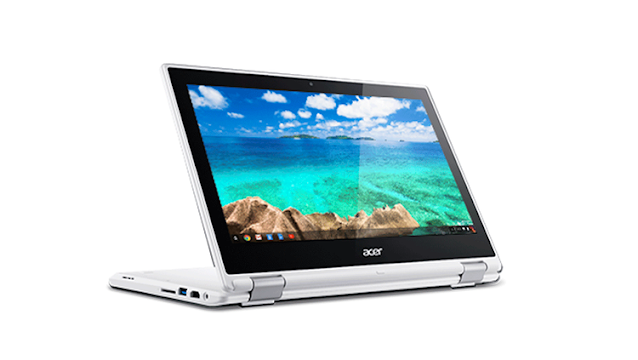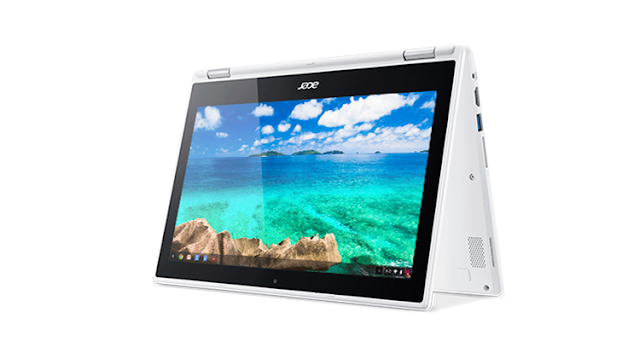Acer's latest Chromebook has a touchscreen with a few special tricks. We find out how useful they really are in our Acer Chromebook R11 review.
Should I Buy The Acer Chromebook R11?
Our Verdict
- The R11 is a decent, if unspectacular device. Having the option to position it in a variety of modes is fun, but the sometimes sluggish performance makes it hard to recommend to anyone who wants to do more than a couple of simultaneous tasks. If your needs are light and you value the flexible hinges though, it’s a nice machine all the same, but we’d still opt to wait for the 4GB alternative.
Price When Reviewed
- US$249.99
Since the release of Windows 10 we’ve seen lots of laptops with touchscreens and hinges enabling them to be transformed into rather heavy, cumbersome tablets. The R11 from Acer takes this format and brings it to a Chromebook, with varying degrees of success.
Of course this isn’t the first Chromebook with a touchscreen. Acer launched one in 2014 and we found it to be a fine machine but the ability to angle the screen in a wide range of motion, from traditional laptop, around to fully flat against the back of the keyboard, makes the R11 here an interesting proposition that could appeal to a lot of users. Asus has also recently gone down this route with its C100P Flip device, so maybe we’ll see this space heat up in the coming months.
Price
With a list price of £229.99 the R11 isn’t overly costly, but you can buy it in white from Currys for just £189.99. Of course Chromebooks are rarely expensive, except for the wonderfully exotic 2015 Chromebook Pixel. The touchscreen does elevate it above some of its competition, and the only direct competition around at the moment is the new Asus C100P Flip, which retails for £249.99, features a smaller 10.1” touchscreen, but can perform the same gymnastic feats as the R11.
If you don’t want these particular features then there are plenty of alternatives that can usually be found for a bit less. Toshiba’s Chromebook 2 is currently one of the best around, with a more spacious 13” screen, great performance, and available on Amazon for £199.
Design
We’ve grown accustomed to Chromebooks being lightweight, slim devices, that instantly promote mobility. It’s a little surprising then to see how relatively bulky the R11 seems at first glance. There are no tapering lines in the chassis, such as those found on the old Samsung Chromebook or Dell Chromebook 11, instead the R11 is quite blockish, with only beveled edges in the keyboard section breaking the industrial-style design. The top section is also thicker than you might expect, but both of these factors to have a sensible cause, and that is stability for the touchscreen.
The two sections are joined by thick silver hinges which give the R11 its major selling point. These dual-torque fittings allow the screen to move through 360 degrees, while being strong enough to hold any position without toppling over. This creates new possibilities for the R11, although how advantageous they are is open to debate.
If you want to watch media on your Chromebook, but don’t want the keyboard sticking out in front, you can position the R11 in Display mode. This is where the screen is folded back until the keyboard is placed facing down on the table and the screen is standing up. It’s a subtle difference, but can mean that the screen is closer to you if space is limited. As you would expect, the keyboard and mousepad are turned off in this mode, but the touchscreen controls make it easy to access controls without having to flip it over.
Move the screen back further and you reach Tent mode. This forms an inverted V shape when looking at the R11 side-on, and adds stability to the device by standing it on the top of the screen and the bottom of the keyboard. Now when you tap the display you get a solid response, plus there’s the advantage that the footprint of the R11 is reduced so you could conceivably use it on an in-flight fold-down table.
The screen itself is an 11.6in IPS display, running at a 1366x768 resolution. It’s bright, clear, and presents colours in an attractive fashion, but off-axis viewing angles curtail pretty quickly. Ports that decorate the chassis include USB 2.0, USB 3.0, HDMI, an SD card reader, plus a standard headphone socket. While Internally Acer has opted to fit an Intel Celeron N3050 1.6GHz CPU, 2GB of RAM, and a 16GB SSD for local storage.
Performance
For all its impressive contortionist tricks the R11 is a let down by a couple of things. In general use it’s a nice little machine. The keyboard is good to type on, the touchscreen is responsive and accurate, but the first stumbling block is the trackpad. Again, for a lot of things it’s perfectly fine, but we did notice a tendency for it to be over-sensitive at times, with the cursor jumping across the screen rather than flowing smoothly. The pad itself is also stiff when clicking, although enabling the tap-to-click option in ChromeOS deals with that issue comfortably.
The main beef, though, is that the R11 feels sluggish when navigating the web - the Number One job for any Chromebook. Pages can take a while to load, and if they have multiple videos loading up you can experience significant delays waiting for the screen to format properly. Several times we noticed that a video open in another tab would stall briefly while we refreshed the Gmail app or clicked on a link.
As we’ve seen on other lower end devices recently, a 2GB RAM allocation isn’t really going to cut it on the modern web. As far as we know, and judging by the listings on Acer’s US site, there should be a 4GB version of the R11 coming out, and we suspect that the shortcomings of this review model would be solved by the simple addition of that extra RAM. That’s not to say that this R11 isn’t worth buying. If you tend to work on one thing at a time, or simply want to stream YouTube videos, movies, or listen to music, then this machine can do that very well.
One standout feature the R11 can boast is its battery life. In our looped video test the device held out for a very impressive nine and a half hours, which would get you through a majority of long haul flights. It's enough for several days of occasional use between charges.
Specs
- Intel Celeron N3050 Dual-core 1.6 GHz / 2.16 GHz with Burst 2MB cache 2 GB RAM 16 GB eMMC SSD storage 11.6" IPS display, 1366 x 768 resolution, with 10-point multitouch capabilities 802.11 ac Bluetooth 4.0 USB 3.0 x 1 USB 2.0 x 1 HDMI x 1 3.5 mm jack SD card reader Integrated stereo speakers HDR webcam 3-cell Lithium-ion battery 19.2 x 294 x 204 mm (H x W x D) Weight 1.25 kg 1 year Manufacturer’s guarantee





0 comments:
Post a Comment